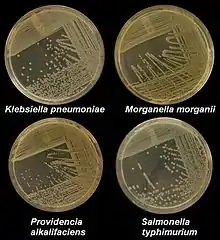Nutrient agar
Nutrient agar is a general purpose medium supporting growth of a wide range of non-fastidious organisms. It typically contains (mass/volume):[1]
- 0.5% Peptone - this provides organic nitrogen
- 0.3% beef extract/yeast extract - the water-soluble content of these contribute vitamins, carbohydrates, nitrogen, and salts
- 1.5% agar - this gives the mixture solidity
- 0.5% Sodium Chloride - this gives the mixture proportions similar to those found in the cytoplasm of most organisms
- distilled water - water serves as a transport medium for the agar's various substances
- pH adjusted to neutral (6.8) at 25 °C (77 °F).

Streak plates of several bacterial species on nutrient agar plates
These ingredients are combined and boiled for approximately one minute to ensure they are mixed and then sterilized by autoclaving, typically at 121 °C (250 °F) for 15 minutes. Then they are cooled to around 50 °C (122 °F) and poured into Petri dishes which are covered immediately. Once the dishes hold solidified agar, they are stored upside down and are often refrigerated until used. Inoculation takes place on warm dishes rather than cool ones: if refrigerated for storage, the dishes must be rewarmed to room temperature prior to inoculation.
References
- American Public Health Association, American Chemical Society, Association of Official Agricultural Chemists (1920). Standard Methods for the Examination of Water and Sewage. American public health association. pp. 95.CS1 maint: multiple names: authors list (link)
Further reading
- Lapage S., Shelton J. and Mitchell T., 1970, Methods in Microbiology', Norris J. and Ribbons D., (Eds.), Vol. 3A, Academic Press, London.
- MacFaddin J. F., 2000, Biochemical Tests for Identification of Medical Bacteria, 3rd Ed., Lippincott, Williams and Wilkins, Baltimore.
- Downes F. P. and Ito K., (Ed.), 2001, Compendium of Methods for the Microbiological Examination of Foods, 4th Ed., American Public Health Association, Washington, D.C.
- American Public Health Association, Standard Methods for the Examination of Dairy Products, 1978, 14th Ed., Washington D.C.
This article is issued from Wikipedia. The text is licensed under Creative Commons - Attribution - Sharealike. Additional terms may apply for the media files.